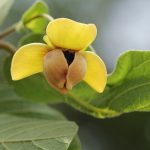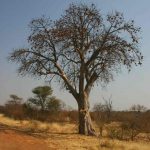TREE LIFE
MAY 1989
MASHONALAND CALENDAR
Tuesday 2nd May: Botanic Garden walk 1645for 1700hours. We hope that Tom Muller will continue where he left off with the FABACEAE.
Sunday 21st May: AGM
The 39th Annual General Meeting of the Tree Society of Zimbabwe will take place at the Ruwa Country Club on Sunday, 21st May at 1000.
- Notice convening the meeting
- Minutes of the last AGM
- Matters arising
- Chairman’sReport
- Treasurer’s Report
- Election of Officers
- Any other business
Any proposals/resolutions and nominations for office bearers should be forwarded to P.O. Box 2128, Harare by 7th May, 1989, if possible, although proposals and nominations will be accepted from the floor. We propose having tea at 0930 hours before the meeting. This will be available from the club at $1 per head. After the meeting we will look at some of the trees on the golf course where we will be doing a labelling exercise in due course, Members’ ideas will be welcome.
A very good lunch can be had at the Club for $9 a head. If interested please advise Phil Haxen on 702561 by Thursday before the meeting so that the club can be advised of approximate numbers. Alternatively members are welcome to have their picnic lunch on the lawns in the garden at Ant and Jen Hardy’s residence which is next door to the club, and which will provide our afternoon venue.
Saturday 27th May: Mukuvisi Woodlands meeting at 1500 hours. Meet at the Paget Road/Inyanga Crescent gate.
MATABELELAND CALENDAR
On Sunday 7th May we will go to Hobart Farm, Marula District, Mrs. Joan Bradshaw. Meet at Graphotype, 81 Mafeking Road, opposite Merlin, at 0830 hours. Cars may be safely left there.
MATABELELAND NOTES
On Sunday April 2nd we went to the Fort Rixon area, to Mankovani Estate, where we enjoyed the kind hospitality of Mr and Mrs Schur. He has a very fine Video camera and recorded out doings and comments on many trees. After lunch we were able to review what we had seen and said. Mr Schur is a skilled operator. It would be a magnificent tool for a planned instructional video. In all we found some 60 tree species. In some ways what we did NOT see is also of note – No Bridelia, no Clerodendrum glabrum, no Dalbergia, no figs, no Erythrina, no Iboza (Tetradenia) no Lannea, No Mimusops, no Strychnos, no Terminalia. The soil was mainly fairly deep, reddish.
Amongst what we did see were Acacia chariessa, Acacia galpinii, A. gerrardii, very many Acacia karroo, A. nilotica, Albizia amara, Azanza garckeana, Berchemia zeyheri, Brachylaena rotundata, Burkea africana one only, a rather dry Canthium huillense (Psydrax livida), first thought to be Canthium lactescens, Carissa bispinosa and C. edulis, Cassine matabelica, a few, and C. transvaalensis, many Celtis africana, Clerodendrum myricoides,
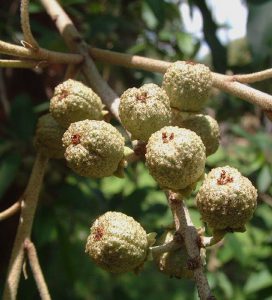
Croton gratissimus. Photo: R. Burrett. Source: Flora of Zimbabwe
Croton gratissimus, even growing on the better soil, as well as more usually among the rocks on the hill, Combretum apiculatum, on the poorer patches, C. erythrophyllum, the river Combretum, quite a few surprisingly, on dryish ground, away from the water course, some fruiting, Combretum hereroense, C. imberbe, Commiphora africana, the poison grub Commiphora, on the rocky hillside, several small Commiphora schimperi nearby, many Diospyros lycioides with some ripe fruit, many Grewia flavescens, flowering, Grewia monticola, a few only, Euclea divinorum, E. undulata, Maytenus heterophylla, the confetti bush, in bud, Mundulea sericea, still flowering a little, Olea europea subsp africana, Ormocarpum trichocarpum, full of hairy caterpillars, Pavetta gardeniifolia, Rhus lancea, R. pyroides, R. tenuinervis, Schotia brachypetala, on the garden edge, Sclerocarya birrea, Securidaca longepedunculata,, the violet tree, Flueggea (Securinega) virosa, Tarchonanthus camphoratus, Ximenia americana and many Ziziphus mucronata.
C. Sykes
MARCH 16TH 1989 OUTING TO ZANKA FARM AND NEIGHBOURING MASHAVA FARM, BEATRICE
Our March outing was into the Beatrice area which is notorious for being familiar to Harare members, yet holding unexpected surprises. The surprises are the result of pockets of Karoo and Kalahari sands in amongst our more familiar Harare type granite and greenstone soils. One of the most obvious anomalies is the Mopani, Colophospermum mopane which made itself conspicuous by its size and shape, even as we were still on the road in our bus. Appropriately, one of the first acacias seen was Acacia karroo. Perhaps the most rewarding find of the morning’s walk was Terminalia randii which we were able to compare with the ubiquitous Terminalia sericea and the other “special” of the afternoon,
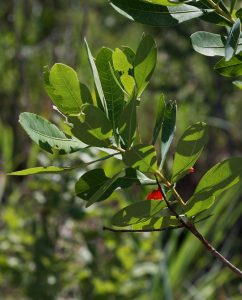
Terminalia brachystemma. Photo: Bart Wursten. Source: Flora of Zimbabwe
Terminalia brachystemma. Some of the other notable finds of the morning walk on the sands were Bolusanthus speciosus, Albizia harveyi, Combretum adenogonium (previously C. fragrans), C. hereroense, in both its hairy and glabrous forms, C. apiculatum, Ormocarpum kirkii and Gardenia ternifolia. The low anthills rewarded us with a profuse variety of species. There were some fine Schotia brachypetala and then Allophylus africanus, Pavetta gardeniifolia, Euclea divinorum, Diospyros lycioides, Ehretia obtusifolia, Carissa edulis (compared later with another special Carissa bispinosa, characterised by its Y shaped thorns), Clerodendrum glabrum and C. myricoides, Maytenus heterophylla, Rhus lancea and Tarchonanthus camphoratus. Crossing on to a low ridge we were almost surprised to see familiar musasas, munondos, etc. Here was a rather fine single-trunked Dalbergia melanoxylon. Lunch was rather a pastoral affair sitting in the shade in a grassy meadow amongst benign cow pats with black and white Friesland/Holsteins looking on whilst nonchalantly chewing their cud. After lunch we were joined by our host Dion Theron just in time to see one of the “mega ticks” of the day. This was Strychnos pungens, which we knew from a previous visit to the Watson Smiths in the same district. This Strychnos has a leaf ending in a sharp spine. If one is unaware of this one can have a most uncomfortable time brushing one’s way past one of these trees. This really is one of those Karroo sand specials. As for the rest that afternoon we were pleased to find a tall Kigelia africana complete with a single sausage, just in case of any doubting Thomases. There were a couple of unusually large Ochna pulchra, although not demonstrating very well the “mermaid” habit of peeling on the upper trunk and branches. The afternoon walk ended with wilting members sitting in the shade of the east side of a small anthill. This rest was justified by an argument (or rather a “polite spirited debate”) over the exact identity of the tree providing shade. In due course, it was agreed that we were indeed being shaded by Vangueria randii.
Our thanks go to Dion Theron and also to Dick and Maureen for some effective recceing.
NOTES ON THE KEY
The trip to Kariba restored my confidence in the key and reminded me how much work has already gone into producing it (since the Tree Society’s last trip to the Valley the key has doubled in length). It was rewarding to see how well everyone coped with the difficult questions – like 96 – which differentiates a spiral arrangement from an alternate arrangement. Each outing highlighted new revisions.
SATURDAY: We discovered Carphalea pubescens (RUBIACEAE) with leaves in whorls of 3 (as well as being opposite). More importantly, we saw its distinctive interpetiolar stipules that are deeply divided to form three-pointed teeth. This feature will help solve the headache with the RUBIACEAE. Combretum apiculatum demonstrated two very different types of leaves on the same tree. The most recent flush had the typical shiny leaves with parallel 3 veins and a twisted apex. But the previous flush had smaller leaves that were densely pubescent with net venation and without any twist at all. While examining Grewia bicolour Tessa described the distinct texture along the undersurface of the leaf as “like talcum powder”, so very apt.
SUNDAY: In the riverine forest beyond the banana farm we discovered Albizia zimmermannii which keyed out well although I had only worked with Tom’s specimen in the gardens. The notorious Combretum padoides and C. elaeagnoides keyed out well although one needs good eyesight, as with Cordyla africana.
MONDAY: An interesting walk in which we checked many trees against the key. Pterocarpus brenanii has conspicuous stipules up to 2.5cm long but I was disturbed to see that these were often absent.
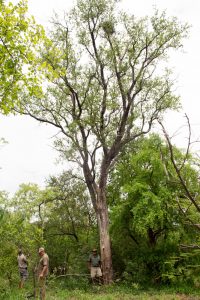
Crossopteryx febrifuga. Photo: P. Ballings. Source: Flora of Zimbabwe.
Crossopteryx febrifuga had pink petioles which is a key feature. The Feretia which grew in the shade beyond the banana farm had failed to show any red, obviously need another revision in the RUBIACEAE. In the meantime, under the auspices of nursing a sick Jemima, Cheryl, Jessica and Mr K. collected enough marulas to keep the jelly pots boiling for three days. The afternoon at Carribea Bay revealed Clerodendron wildii which was not on the key, and many Pterocarpus brenanii. Meg’s walk explored some delightful woodland. We then had fun demonstrating how the speed of a roundabout increases when one moves to the outside – an old game I have not indulged in for years. Trees gave way to tea, swims, a baobab inspection and the super tube which Mr K. experienced in wide-eyed terror but without tears or a repeat performance.
TUESDAY: The morning on the peak is documented by Cheryl. Our afternoon visit to the dam wall demonstrated many Moringa oleifera planted along the road side. They key out easily as there are not many tricompound trees in the Valley. The visit to the crocodile farm entertained more than just the kids and pointed out errors with Ximenia americana and Terminalia stuhlmannii. On the return journey through the high density residential area we saw many Ziziphus mauritiana which also needed modification on the key. There is obviously much still to be done, most important is to retype the quarter of the key which I lost by simply pressing a button on the computer after I had printed out the last edition!
Kim Damstra.
TUESDAY: Upon our return to the Peak Road, we examined plants along the roadside and discovered a whole array of species not seen on the slopes the day before. A Ficus abutilifolia with its very large red-veined leaves and white bark had its roots poured over a rock, perched on the edge of a precipitous slope. Nearby, a plant with striking shaving brush flowers, caused some members to descend risking life and limb. This turned out to be Courbonia glauca (formerly Maerua edulis) a small blue green shrub whose last clue in the key we were using, describes it as smelling of a hamster’s nest. And indeed it did! A new species to most of us, seemed to be an obvious combretum, with the typical winged fruit. However it turned out to be Meiostemon tetrandrus (false combretum), a plant almost indistinguishable from the combretums, differing only in the number of stamens in the flowers. Like the other “near combretums” Pteleopsis sp. the fruits are very small characteristic of Meiostemon is the fine reddish epidermis which peels off the small branchlets. Very common in the area was Albizia brevifolia (mountain albizia) a finely bipinnately leafed leaf, similar in appearance to A. harveyi. It was distinguished from this species by its rather blue green appearance, and leaflets straight with rounded apex, as opposed to the rather sickle-shaped leaflets of A. harveyi. The habitat, hot dry slopes, was as expected, and as its distribution is patchy, we considered this sighting a real bonus (particularly as the trees were adorned with many pods with unparasitised seeds). Terminalia sambesiaca was also quite a find, and again enabled us to show the value of the key. The terminalias can look much alike, but the key differentiated this species from T. stenostachya and T. mollis on the lack of “craters” i.e. indented scars from fallen leaves in T. sambesiaca. Somewhat further down we discovered a large Commiphora caerulea (blue bark commiphora). It showed perfectly the pale yellow papery bark coming off in flakes, revealing the smooth milky blue bark beneath. Nearby was C. marlothii with its beautiful bright green trunk revealed by the large sheets of outer bark peeling off like paper. We were by now well satisfied with the day’s findings, but better was to come. An odd-looking fig turned out to be Ficus nigropunctata. Not only is this species a very rare sight for us, but it does not appear on distribution maps for this area. The black branches with conspicuous white lenticels are the real test for this fig. Undoubtedly, this was the highlight of the day. To complete the outing we stopped on the way back to see a large Stereospermum kunthianum (pink jacaranda), unfortunately not in flower. Across the road were some very similar trees which after much argument and pouring over the key, turned out to be Markhamia acuminata. While the leaves of these two are very similar, the pink jacaranda has yellow leaf veins and the Markhamia’s venation is green. A good end to a productive day.
C.Haxen
This month we begin a new feature on Tree Life. Elspeth Baillie from Chikwenya Camp (downstream from Mana Pools) brings us news from the ever-changing Zambezi Valley.
Chikwenya Camp, 19th April 1989: On our arrival at camp the Acacia albida (Faidherbia albida) were bare of leaf – ghostly grey silhouettes above the green grasslands. Some were just beginning to acquire a faint misting of limey green. During the month they have flushed, and most are now in full sea green leaf. Some individuals have actually produced their first flowers already, but these are exceptional. The Vetiveria grass is thick and festooned with high flowering heads, and the general grass cover is good this year. The grasses were still green in mid March but they are drying out rapidly, and are now predominantly yellowy brown, and are seeding heavily, to the advantage of the numerous Red Billed Quelea. During the month there has been a noticeable growth of some plants, such as Cassia obtusifolia, presumably brought on by the late rains. Autumn is the “season of … mellow fruitfulness”, and we have seen Friesodielsia obovata and Tamarindus indica in full fruit, and the
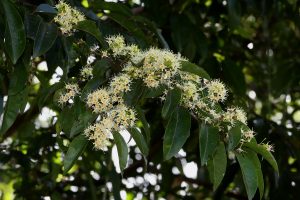
Pteleopsis myrtifolia. Photo: Bart Wursten. Source: Flora of Zimbabwe.
Pteleopsis myrtifolia with its small winged pods. The Holmskioldia tettensis is adorned with an array of “Chinese hats” and the Strophanthus kombe has sprouted its large moustache like pods. We have found a Kigelia Africana with a few flowers – much too early for the main flowering, we wonder what would have caused this unseasonal outburst. The loranthus parasites are flowering colourfully, both the scarlet and the yellow species, and they are particularly noticeable growing in the Berchemia discolor. The jesse is still very thick and impenetrable and we have noticed in particular the sand ash, Xylia torreana in lush leaf.
By the way the undescribed species of Coffea is being heavily eaten by something, or is it a disease?
FOOT NOTE JASPER is an impure form of silica, a mixture of quartz and red oxide used since early times as an ornamental stone. Were you one of the lucky members who paid a visit to Usasa Farm in the Chegutu area in September 1986 where one of the exciting finds were rocks of jasper. Kim describes how “on arriving on the jasperlite we had much to do and find and people all went fossicking off. We learned about banded jasper, picture jasper and found some amazing colours”. Now Dorothy Popiel of Harare writes :
“Next time members are passing through Kadoma stop at the Library and ask to see the fascinating mineral collection. “Picture Jasper” is the main attraction and it comes in many forms, geometric patterns of rainbow colours, to and three coloured rocks with imagination pictures, can you find the rooster, spaceman, etc., and perhaps best of all the dendrite pictures such as ‘crinoline lady with howling dog’. Allow yourselves more than ten minutes though; it is fascinating and fun for the whole family.”
DICK HICKS CHAIRMAN


